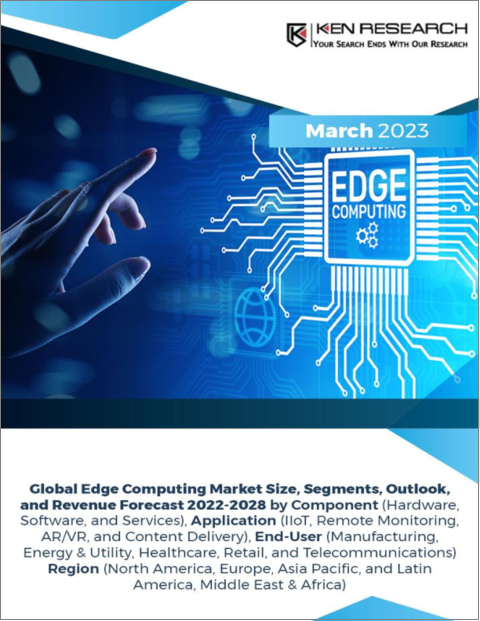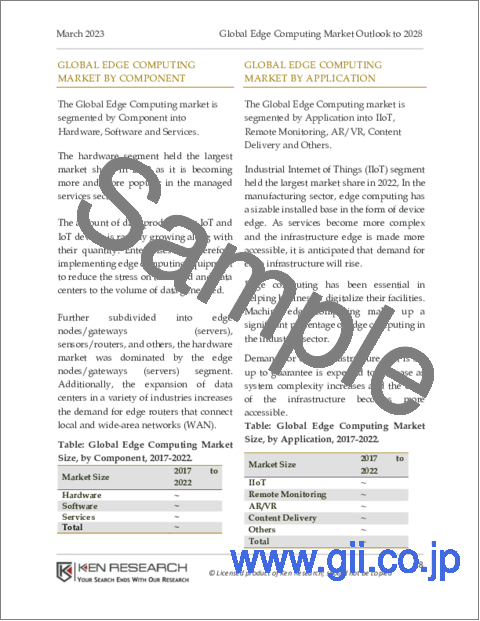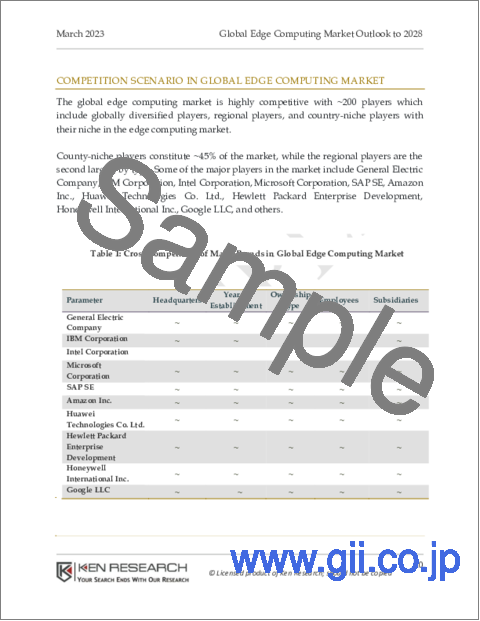|
|
市場調査レポート
商品コード
1163394
エッジコンピューティングの世界市場-市場規模、セグメント、展望、収益予測:コンポーネント別、用途別、エンドユーザー別、地域別(2022年~2028年)Global Edge Computing Market Size, Segments, Outlook, and Revenue Forecast 2022-2028 by Component, Application, End-User Region |
||||||
| エッジコンピューティングの世界市場-市場規模、セグメント、展望、収益予測:コンポーネント別、用途別、エンドユーザー別、地域別(2022年~2028年) |
|
出版日: 2022年11月29日
発行: Ken Research Private Limited
ページ情報: 英文
納期: お問合せ
|
- 全表示
- 概要
- 目次
世界のエッジコンピューティングの市場規模は、2017年に約30億米ドル、2022年に約80億米ドルに達し、2028年には約200億米ドルに達する見込みで、予測期間中に16%のCAGRで成長すると予測されています。5Gの普及と分散型データ処理能力に対する需要の高まりは、市場の成長を促進しています。しかし、多数のノードからのネットワークトラフィックの増加が、市場の成長を抑制しています。
当レポートでは、世界のエッジコンピューティング市場について調査分析し、主要な動向、競合情勢、市場分析など、体系的な情報を提供しています。
目次
第1章 エグゼクティブサマリー
- 世界のエッジコンピューティング市場の成長実績と予測のハイライト
- 市場動向、課題、競合のハイライト
- 市場収益シェアのハイライト:セグメント別
第2章 市場概要と成長に影響を与える主要な動向
- 世界のエッジコンピューティング市場の分類法
- 業界のバリューチェーン
- 世界のエッジコンピューティング市場における主要企業のエコシステム
- 政府の規制と開発
- 市場に影響を与える主要な促進要因と課題
- 世界のエッジコンピューティング市場へのCOVID-19の影響
- 世界のエッジコンピューティング市場の成長実績(2017年~2021年):セグメントタイプ別
- コンポーネント別
- 用途別
- エンドユーザー別
- 地域別
- 全世界のエッジコンピューティング市場の実績と予測の成長(2017年~2028年)
- 重要ポイント
第3章 世界の市場セグメンテーション、成長実績、展望、予測:コンポーネント別
- 市場の定義-セグメンテーション:コンポーネント別
- 市場収益シェア、成長実績、展望、予測(2017年~2028年):コンポーネント別
- ハードウェア
- ソフトウェア
- サービス
- 市場セグメンテーションからの重要ポイント:コンポーネント別
第4章 世界の市場セグメンテーション、成長実績、展望、予測:用途別
- 市場の定義-セグメンテーション:用途別
- 市場収益シェア、成長実績、展望、予測(2017年~2028年):用途別
- IIoT
- AR/VR
- コンテンツ配信
- リモート監視
- その他
- 市場セグメンテーションからの重要なポイント:用途別
第5章 世界の市場セグメンテーション、成長実績、展望、予測:エンドユーザー別
- 市場の定義-セグメンテーション:エンドユーザー別
- 市場収益シェア、成長実績、展望、予測(2017年~2028年):エンドユーザー別
- 製造
- ヘルスケア
- エネルギーとユーティリティ
- 電気通信
- その他
- 市場セグメンテーションからの重要なポイント:エンドユーザー別
第6章 業界/競合分析-競合情勢
- 企業(競合企業)のタイプと競合シェア
- 世界のエッジコンピューティングの競合のポーターのファイブフォース分析
- 市場の成長に影響を与える世界のエッジコンピューティングセクターの主な開発
- 世界のエッジコンピューティング市場における主要な競合の比較(2021年)
- 世界のエッジコンピューティング市場における主要な競合の比較(2021年):コンポーネント範囲別
- 世界のエッジコンピューティング市場における主要な競合の比較(2021年):用途範囲別
- 世界のエッジコンピューティング市場における主要な競合の比較(2021年):エンドユーザー範囲別
- 世界のエッジコンピューティング市場における主要な競合の比較(2021年):地域範囲別
- 競合情勢からの重要ポイント
第7章 主要な競合企業プロファイル(企業概要、タイプオファリング、強みと弱み)
- DSM
- General Electric Company
- IBM Corporation
- Intel Corporation
- Microsoft Corporation
- SAP SE
- Amazon Inc.
- Huawei Technologies Co. Ltd.
- Hewlett Packard Enterprise Development
- Honeywell International Inc.
- Google LLC
第8章 地域分析と主要地域市場の成長実績、展望、予測
- マクロ経済要因の主要地域比較
- 全世界市場収益シェア、成長実績、地域予測(2017年~2028年):地域別
- 主要地域の市場分析、成長実績、展望、予測
- 北米-エッジコンピューティング市場分析
- 欧州-エッジコンピューティング市場分析
- アジア太平洋-エッジコンピューティング市場分析
- ラテンアメリカ、中東、アフリカ-エッジコンピューティング市場分析
第9章 業界専門家の意見/展望
- 市場の現状と将来の展望に関する業界専門家と経営幹部の注目すべき声明/引用
第10章 アナリストの推奨
- 特定された主要な機会と機会から得られる可能性のある戦略に関するアナリストの推奨事項
第11章 付録
- 調査手法-市場規模の推定、予測、および健全性チェックのアプローチ
- サンプルディスカッションガイド
免責事項
Market Overview
Edge computing adds to the organization's complexity by allowing a broad group of stakeholders to maintain IT infrastructures, networking, software development, traffic distribution, and service administration. Edge further blends networking architecture, software, and hardware solutions to address a range of use cases across numerous industries. The development of edge computing is still in its early stages. Although its operational and deployment models have not yet developed, edge computing is anticipated to present considerable growth opportunities for new entrants in the coming years.
According to Ken Research Analysis, the Global Edge Computing Market was valued at ~US$ 3 billion in 2017. It is estimated to be ~US$ 8 billion by 2022 and is expected to reach a market size of ~US$ 20 billion by 2028 growing at a CAGR of ~16% during the forecast period (2022-2028). Edge computing demand is anticipated to increase as a result of the rollout of 5G and the rising demand for decentralized data processing capability.
Edge computing use cases include the consumer desire for high-performance smartphone applications like high-definition multiplayer online battle arena (MOBA) games. Edge computing and the Internet of Things (IoT) offer attractive potential for edge computing architecture in developing nations like China, India, and Indonesia.
Since the storage and computing power of edge nodes is constrained, a well-equipped system is needed to connect the edge and the cloud. The barrier to the growth of the edge computing market will be the rise in network traffic from numerous nodes. Even when they are employing high bandwidth needs, many IT professionals still have the same problems.
Data centers and edge computing are now used more frequently due to the COVID-19 pandemic. Businesses across a wide range of industry sectors have scaled back their spending in upgrading servers and software to significantly reduce costs. Due to the ongoing focus on improving communications infrastructure, edge computing demand has increased since the COVID-19 outbreak and will continue to climb over the next years. In addition, a network design that demands high security and low latency connectivity are growing alongside the healthcare system as it has gained traction through online consultations.
Scope of the Report
The edge computing market is segmented by component, application, and end-user. In addition, the report also covers market size and forecasts for the four region's edge computing markets. The revenue used to size and forecast the market for each segment is US$ billion.
By Component
Hardware
Software
Services
By Application
IIoT
Remote Monitoring
AR/VR
Content Delivery
Others
By End-User
Manufacturing
Energy & Utility
Healthcare
Telecommunications
Retail
Others
By Geography
North America (USA, Canada, Mexico)
Europe (Germany, UK, France, Spain, Italy)
Asia-Pacific (China, Japan, South Korea, India, Indonesia, Australia)
LAMEA (Latin America, Middle East, Africa)
Leading Companies
General Electric Company
IBM Corporation
Intel Corporation
Microsoft Corporation
SAP SE
Amazon Inc.
Huawei Technologies Co. Ltd.
Hewlett Packard Enterprise Development
Honeywell International Inc.
Google LLC
Key Trends by Market Segment
By Component: The hardware segment held the largest market share in 2021 as it is becoming more and more popular in the managed services sector.
The amount of data produced by IoT and IoT devices is rapidly growing along with their quantity. Enterprises are therefore implementing edge computing equipment to reduce the stress on the cloud and data centers to the volume of data generated.
Further subdivided into edge nodes/gateways (servers), sensors/routers, and others, the hardware market was dominated by the edge nodes/gateways (servers) segment. Additionally, the expansion of data centers in a variety of industries increases the demand for edge routers that connect local and wide-area networks (WAN).
By Application: Industrial Internet of Things (IIoT) segment held the largest market share in 2021, In the manufacturing sector, edge computing has a sizable installed base in the form of device edge. As services become more complex and the infrastructure edge is made more accessible, it is anticipated that demand for edge infrastructure will rise.
Edge computing has been essential in helping businesses digitalize their facilities. Machine edge computing makes up a significant percentage of edge computing in the industrial sector.
Demand for edge infrastructure that is set up to guarantee is expected to increase as system complexity increases and the edge of the infrastructure becomes more accessible.
By End-User: Energy & utility segment held the largest market share in 2021, smart grids, which rely on device-edge infrastructure, are probably going to help the energy and utility sector's income grow.
Global attempts to increase the efficiency of electrical utility services, including the development of alternative renewable power sources like solar and wind, are being fueled by environmental sustainability programs.
In order Tocapabilities and improve operating efficiencies, smart grids are being implemented all over the world. These networks can support microgrids to support generation from dispersed renewable sources, real-time consumption control, and integration with smart appliances.
By Geography: North Americasegment held the largest market share in 2021, The convergence of IIoT and edge computing is creating favorable conditions for manufacturers in the USA to transition to connected manufacturing.
Several startups have also emerged to provide platforms for building edge-enabled solutions, which are expected to help the regional market's growth. For instance, the MobiledgeX Early Access Program was developed in cooperation between Telus Communications and MobiledgeX, Inc. The software has made it possible for programmers to create, test, and evaluate the effectiveness of edge-enabled apps in a low-latency setting.
Competitive Landscape
The global edge computing market is highly competitive with ~200 players which include globally diversified players, regional players, and country-niche players with their niche in the edge computing market.
County-niche players constitute ~45% of the market, while the regional players are the second largest by type. Some of the major players in the market include General Electric Company, IBM Corporation, Intel Corporation, Microsoft Corporation, SAP SE, Amazon Inc., Huawei Technologies Co. Ltd., Hewlett Packard Enterprise Development, Honeywell International Inc., Google LLC, and others.
Recent Developments Related to Major Players
In June 2022, SixSq announced their continued collaboration to provide Nuvla Marketplace users with intelligent sound-embedded software that can analyze particular sounds in any situation. The unique sound processing technology from Securaxis can now be purchased, deployed, and managed much more easily thanks to this agreement.
In May 2022, Litmus and Google Cloud collaborated to create the Manufacturing Connect platform, which simplifies the hard operation of collecting data from different industrial equipment and exposing it to Google Cloud data and Al applications. A factory edge platform called Manufacturing Connect is designed specifically to accommodate more than 250 machine communication protocols right out of the box. For advanced analytics and Al, data is organized, stored locally, and transmitted to Google Cloud. For closed loop Al, the platform can manage and deploy machine learning and AI models at the edge.
In April 2022, Dell Technologies expanded its edge solutions to assist retailers in fast generating more value and providing superior customer experiences based on data gathered in retail locations. To keep up with market demands and improve consumer experiences, retailers have adopted cutting-edge technologies in everything from supermarket merchandising and curbside pickup to seamless checkout and loss prevention.
Conclusion
The global edge computing market is forecasted to continue the growth that is witnessed since 2017, edge computing is a method that handles data processing at the network's edge. For instance, a mobile phone might be an edge device in the telecom industry. As a result, every device that produces data near the network's edge serves as an edge device. The primary drivers of the growth of the worldwide edge computing market include variables like the rise in the number of intelligent apps and the increased global strain on cloud infrastructure. Though the market is highly competitive with ~200 players, few global players control the dominant market share and regional players also hold a significant market share.
Note: This is an On-Demand/Planned report, so the figures quoted here for a market size estimate, forecast, growth, segment share, and competitive landscape are based on initial findings and might vary slightly in the actual report. Also, any required customizations can be covered to the best feasible extent for Pre-booking clients, and the report delivered within a maximum of two working weeks.
Key Topics Covered in the Report
Snapshot of the Global Edge Computing Market
Industry Value Chain and Ecosystem Analysis
Market size and Segmentation of the Global Edge Computing Market
Historic Growth of the Overall Global Edge Computing Market and Segments
Competition Scenario of the Market and Key Developments of Competitors
Porter's 5 Forces Analysis of the Global Edge Computing Industry
Overview, Type Offerings, and Strengths & Weaknesses of Key Competitors
COVID-19 Impact on the Overall Global Edge Computing Market
Future Market Forecast and Growth Rates of the Total Global Edge Computing Market and by Segments
Market Size of Application Segments with Historical CAGR and Future Forecasts
Analysis of Global Edge Computing in Major Regions
Major Type/Supply and Consumption/Demand Hubs within Each Region
Major Country-wise Historic and Future Market Growth Rates of the Total Market and Segments
Overview of Notable Emerging Competitor Companies within Each Major Region
Major Players Mentioned in the Report
General Electric Company
IBM Corporation
Intel Corporation
Microsoft Corporation
SAP SE
Amazon Inc.
Huawei Technologies Co. Ltd.
Hewlett Packard Enterprise Development
Honeywell International Inc.
Google LLC
Notable Emerging Companies Mentioned in the Report
EdgeConnex Inc.
ClearBlade
Digi International
Axellio
Key Target Audience - Organizations and Entities Who Can Benefit by Subscribing This Report
Edge Computing Companies
Edge Computing Association
Cloud Server Manufacturers
Networking Equipment Manufacturers
Research & Development Institutes for Edge Computing
Edge Computing Manufactures
Technology Research Associations
Edge Computing Solution Suppliers
Edge Computing Component Providers
Investment Banks Targeting Edge Computing Market
PE and VC Firms Targeting Edge Computing Industry
Government Ministries and Departments of Information Technology
Government Ministries and Departments of Communications Industry
Potential Entrants into Edge Computing Industry
Frequently Asked Questions
What is the Study Period of this Market Report?
The Global Edge Computing Market is covered from 2017-2028 in this report, which includes a forecast for the period 2022-2028.
What is the Future Growth Rate of the Global Edge Computing Market?
The Global Edge Computing Market is expected to witness a CAGR of about 16% over the next six years.
What are the Key Factors Driving the Global Edge Computing Market?
Edge computing use cases include the consumer desire for high-performance smartphone applications like high-definition multiplayer online battle arena (MOBA) games. Edge computing and the Internet of Things (IoT) offer attractive potential for edge computing architecture in developing nations like China, India, and Indonesia.
Which is the Largest Component Segment within the Global Edge Computing Market?
The hardware segment held the largest market share in 2021 since it is becoming more and more popular in the managed services sector.
Who are the Key Players in the Global Edge Computing Market?
General Electric Company, IBM Corporation, Intel Corporation, Microsoft Corporation, SAP SE, Amazon Inc., Huawei Technologies Co. Ltd., Hewlett Packard Enterprise Development, Honeywell International Inc., Google LLC, and others are the major companies operating in Global Edge Computing Market.
Table Of Contents
Scope
1. Executive Summary
- 1.1 Highlights of Global Edge Computing Market Historic Growth & Forecast
- 1.2 Highlights of Market Trends, Challenges, and Competition
- 1.3 Highlights of Market Revenue Share by Segments
2. Market Overview and Key Trends Impacting Growth
- 2.1 Global Edge Computing Market Taxonomy
- 2.2 Industry Value Chain
- 2.3 The Ecosystem of Major Entities in the Global Edge Computing Market
- 2.4 Government Regulations & Developments
- 2.5 Key Growth Drivers & Challenges Impacting the Market
- 2.6 COVID-19 Impact on Global Edge Computing Market
- 2.7 Total Global Edge Computing Market Historic Growth by Segment Type, 2017-2021
2.7.1 By Component
2.7.2 By Application
2.7.3 By End-User
2.7.4 By Region
- 2.8 Total Global Edge Computing Market Historic & Forecast Growth, 2017-2028
- 2.9 Key Takeaways
3. Total Global- Market Segmentation by Component, Historic Growth, Outlook & Forecasts
- 3.1 Market Definition - Segmentation by Component
- 3.2 Market Revenue Share, Historic Growth, Outlook, and Forecasts by Component, 2017-2028
3.2.1 Hardware
3.2.2 Software
3.2.3 Services
- 3.3 Key Takeaways from Market Segmentation by Component
4. Total Global- Market Segmentation by Application, Historic Growth, Outlook & Forecasts
- 4.1 Market Definition - Segmentation by Application
- 4.2 Market Revenue Share, Historic Growth, Outlook, and Forecasts by Application, 2017-2028
4.2.1 IIoT
4.2.2 AR/VR
4.2.3 Content Delivery
4.2.4 Remote Monitoring
4.2.5 Others
- 4.3 Key Takeaways from Market Segmentation by Application
5. Total Global- Market Segmentation by End-User, Historic Growth, Outlook & Forecasts
- 5.1 Market Definition - Segmentation by End-User
- 5.2 Market Revenue Share, Historic Growth, Outlook, and Forecasts by End-User, 2017-2028
5.2.1 Manufacturing
5.2.2 Healthcare
5.2.3 Energy & Utility
5.2.4 Telecommunications
5.2.5 Others
- 5.3 Key Takeaways from Market Segmentation by End-User
6. Industry / Competition Analysis - Competitive Landscape
- 6.1 Types of Players (Competitors) & Share of Competitors
- 6.2 Porter's 5 Forces Analysis of Global Edge Computing Competitors
- 6.3 Key Developments in the Global Edge Computing Sector Impacting Market Growth
- 6.4 Comparison of Leading Competitors within the Global Edge Computing Market, 2021
- 6.5 Comparison of Leading Competitors within the Global Edge Computing Market by Coverage of Component Segments, 2021
- 6.6 Comparison of Leading Competitors within the Global Edge Computing Market by Coverage of Application Segments, 2021
- 6.7 Comparison of Leading Competitors within the Global Edge Computing Market by Coverage of End-User Segment, 2021
- 6.8 Comparison of Leading Competitors within the Global Edge Computing Market by Coverage of Region, 2021
- 6.9 Key Takeaways from Competitive Landscape
7. Key Competitor Profiles (Company Overview, Type Offerings, and Strengths & Weaknesses)
- 7.1 DSM
- 7.2 General Electric Company
- 7.3 IBM Corporation
- 7.4 Intel Corporation
- 7.5 Microsoft Corporation
- 7.6 SAP SE
- 7.7 Amazon Inc.
- 7.8 Huawei Technologies Co. Ltd.
- 7.9 Hewlett Packard Enterprise Development
- 7.10 Honeywell International Inc.
- 7.11 Google LLC
8. Geographic Analysis & Major Region Market Historic Growth, Outlook, and Forecasts
- 8.1 Major Region Comparison of Macroeconomic Factors
- 8.2 Total Global- Market Revenue Share, Historic Growth, Outlook and Forecasts by Geography, 2017-2028
- 8.3 Major Region Market Analysis, Historic Growth, Outlook & Forecasts
- 8.4 North America - Edge Computing Market Analysis
8.4.1 Major Remote Monitoring and Consumption Hubs in North America
8.4.2 Notable Emerging Edge Computing Companies in North America
8.4.3 Market Revenue Share, Historic Growth, Outlook, and Forecasts by Component, 2017-2028
8.4.4 Market Revenue Share, Historic Growth, Outlook, and Forecasts by Application, 2017-2028
8.4.5 Market Revenue Share, Historic Growth, Outlook, and Forecasts by End-User, 2017-2028
8.4.6 Market Revenue Share, Historic Growth, Outlook, and Forecasts by Major Countries, 2017-2028
USA
Canada
Mexico
- 8.5 Europe - Edge Computing Market Analysis
8.5.1 Major Remote Monitoring and Consumption Hubs in Europe
8.5.2 Notable Emerging Edge Computing Companies in Europe
8.5.3 Market Revenue Share, Historic Growth, Outlook, and Forecasts by Component, 2017-2028
8.5.4 Market Revenue Share, Historic Growth, Outlook, and Forecasts by Application, 2017-2028
8.5.5 Market Revenue Share, Historic Growth, Outlook, and Forecasts by End-User, 2017-2028
8.5.6 Market Revenue Share, Historic Growth, Outlook, and Forecasts by Major Countries, 2017-2028
Germany
UK
France
Spain
Italy
Rest of Europe
- 8.6 Asia-Pacific - Edge Computing Market Analysis
8.6.1 Major Remote Monitoring and Consumption Hubs in Asia-Pacific
8.6.2 Notable Emerging Edge Computing Companies in Asia-Pacific
8.6.3 Market Revenue Share, Historic Growth, Outlook, and Forecasts by Component, 2017-2028
8.6.4 Market Revenue Share, Historic Growth, Outlook, and Forecasts by Application, 2017-2028
8.6.5 Market Revenue Share, Historic Growth, Outlook, and Forecasts by End-User, 2017-2028
8.6.6 Market Revenue Share, Historic Growth, Outlook, and Forecasts by Major Countries, 2017-2028
China
Japan
South Korea
India
Indonesia
Australia
Rest of Asia-Pacific
- 8.7 LAMEA - Edge Computing Market Analysis
8.7.1 Major Remote Monitoring and Consumption Hubs in LAMEA
8.7.2 Notable Emerging Edge Computing Companies in LAMEA
8.7.3 Market Revenue Share, Historic Growth, Outlook, and Forecasts by Component, 2017-2028
8.7.4 Market Revenue Share, Historic Growth, Outlook, and Forecasts by Application, 2017-2028
8.7.5 Market Revenue Share, Historic Growth, Outlook, and Forecasts by End-User, 2017-2028
8.7.6 Market Revenue Share, Historic Growth, Outlook, and Forecasts by Major Sub-Regions, 2017-2028
Latin America
Middle East
Africa
9. Industry Expert's Opinions/Perspectives
- 9.1 Notable Statements/Quotes from Industry Experts and C-Level Executives on Current Status and Future Outlook of the Market
10. Analyst Recommendation
- 10.1 Analyst Recommendations on Identified Major Opportunities and Potential Strategies to Gain from Opportunities
11. Appendix
- 11.1 Research Methodology - Market Size Estimation, Forecast, and Sanity Check Approach
- 11.2 Sample Discussion Guide
Disclaimer




